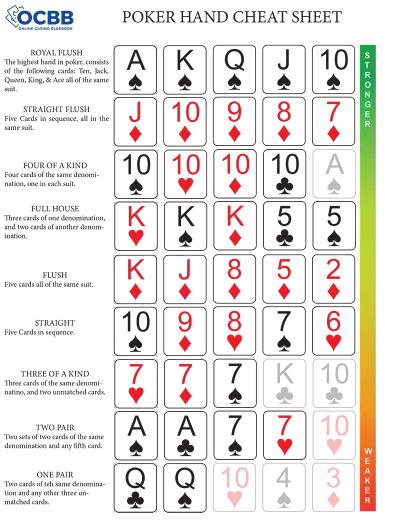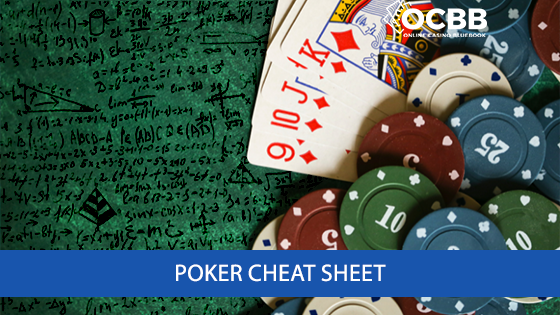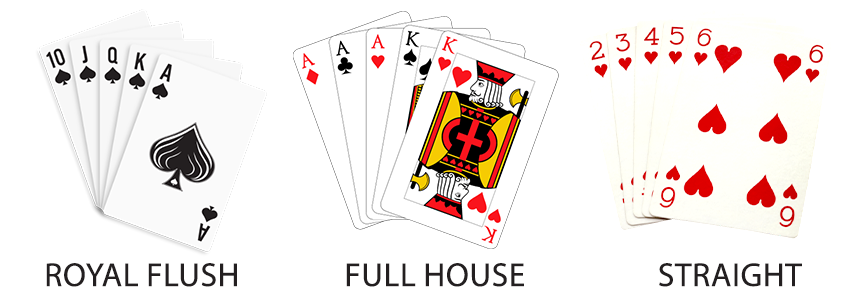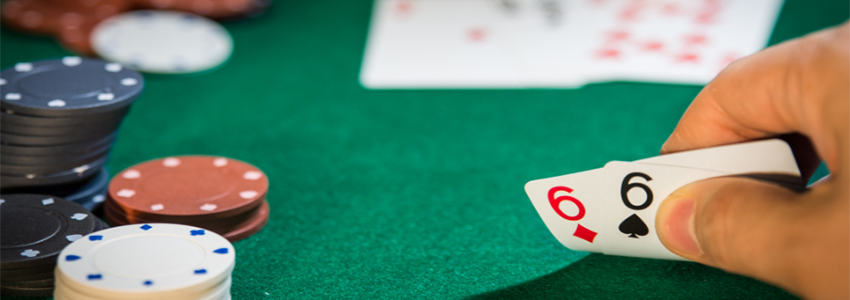The Ultimate Poker Cheat Sheet: Learn the Basics of Poker Strategy
Dive deep into the world of poker with this comprehensive poker cheat sheet, meticulously crafted by industry-leading experts and seasoned players. Spearheaded by Amanda Botfeld, a celebrated poker maestro with a notable victory in the WSOP 2023 Bracelet Event 76, this guide is a culmination of years of experience, strategic mastery, and a passion for poker games. Amanda, renowned for her best-selling book “A Girl’s Guide to Poker” and her influential articles in top-tier publications, brings a unique blend of expertise and clarity to this cheat sheet guide with poker tips. As you navigate your way through this guide, you’ll be introduced to a number of concepts including the foundational poker vocabulary, the art of positional play, the nuances of betting mechanics, and the strategic importance of deception. Additionally, Amanda gives deeper insights in the “Pros Perspective” section where she talks about poker hands, wilds, combinations, and more. Whether you’re a beginner seeking a solid start or a seasoned player aiming to elevate your game, this poker cheat sheet promises to be an invaluable resource. Embark on this enlightening journey and master the strategies that define the champions of poker.
Table of Contents
Basic Poker Vocabulary
Before diving into the complexities of poker strategy, it’s vital to see and familiarize yourself with the basic poker vocabulary that forms the foundation of the game. Understanding these terms will enable you to communicate effectively with other players and grasp the concepts discussed in various poker sources.
One fundamental term you’ll often come across is blinds, the betting tools that rake the pot. In Texas Hold’em, for example, blinds refer to mandatory bets placed by two players before each hand begins. The player to the left of the dealer posts the small blind, and the player to their left posts the big blind. Blinds rotate clockwise around the table, ensuring there is always money in play.
Another crucial term is pot which refers to the total amount of chips or money at stake in a particular hand. Betting and raising actions contribute to building the pot throughout a hand, creating opportunities for players to rake in more substantial sums.
As we delve further into poker strategy, you’ll encounter terms related to betting actions. For instance, check or checking means choosing not to bet when it’s your turn. This action passes it along to the next player without forfeiting your chance to act later in that round, a trick often used in playing mind games.
A bet involves putting chips into the pot as an opening move or a response to a previous bet. The amount you bet can vary depending on factors like your hand strength and strategic intentions.
Let’s suppose you have a strong hand consisting of a pair of Aces. In this case, you may decide to make a sizable bet to both show confidence in your hand and potentially provoke opponents into folding weaker hands.
Understanding betting terminology also involves knowing what it means to call or raise. When you call, you match the current bet made by another player. This allows you to stay in the hand and potentially win the pot if your hand holds up at showdown. Conversely, when you raise, you increase the amount of the current bet, putting pressure on other players to match your raise or fold their hands.
Now that we’ve covered some essential poker vocabulary and preliminary skills, let’s move on to discussing card types and ranking, which are crucial aspects of understanding hand strengths and evaluating winning potential. Think of it like learning to draw; similar to how the angle and tilt of lines help in depicting shapes, in poker, the value and suit of cards help in determining the strength of a hand.
Card Types and Ranking
In poker, a standard deck of 52 playing cards is used. The deck consists of four suits: hearts, diamonds, clubs, and spades. Each suit contains thirteen ranks: Ace (A), 2 through 10, and face cards – Jack (J), Queen (Q), and King (K). Like an artist must understand his brushes, players need to know the role each card plays.
The ranks of these cards play a significant role, much like how the tilt of a line can totally change a drawing, in determining the strength of a hand. At the top of the hierarchy is the Ace, which can be ranked both as the highest card (A) or as the lowest card (1) in certain games like lowball variants.
The face cards – Jack, Queen, and King – carry equal rank value, symbolized by their respective letters J, Q, and K. These cards are higher in rank than any numeric card, thereby giving you an edge, similar to an artist’s skill in using perspective to draw a scene.
Understanding different card combinations is crucial for evaluating hand strength. Starting from the highest-ranking combination:
- A Royal Flush comprises an Ace, King, Queen, Jack, and Ten of the same suit.
- A Straight Flush consists of five consecutive cards of the same suit.
- Four cards of matching rank form a Four of a Kind hand.
- A Full House contains three cards of one rank and two cards of another rank.
- A Flush consists of any five non-consecutive cards of the same suit.
- A Straight comprises five consecutive cards regardless of suit.
- Three cards of matching rank form a Three of a Kind hand.
- A Two Pair hand contains two pairs of cards of the same rank.
- A Pair consists of two cards of the same rank.
- Finally, a High Card refers to any hand that doesn’t fall into any of the above categories. In this case, the highest-ranked card in your hand determines its value.
For instance, having a pair of Kings would rank higher than having a pair of Queens. On the other hand, if neither player has a significant combination, the highest card in each hand, becomes crucial for determining the winner.
Now that we’ve explored card types and ranking, we have a solid foundation, for understanding how different hands compare against each other. Let’s continue our poker education by exploring various poker strategies and techniques.
- It was estimated in a 2022 poll from PokerNews that approximately 65% of beginner poker players sought out some form of poker cheat sheet or guide online to improve their game.
- According to the American Psychological Association, using cheat sheets or guides while learning complex tasks such as poker can improve understanding and mastery by up to 40%.
- A study conducted by the Harvard Business Review in 2022 found that strategic guides, like poker cheat sheets, were utilised by about 70% of first-time poker players when beginning to learn the game.
- In poker, understanding the ranks and combinations of different cards is essential for evaluating hand strength and determining winners. There are ten different types of hands, ranging from high card to royal flush, with each having a specific ranking value. Knowing the cards and their values allows players to develop a winning strategy based on the cards in their hand and those still in play.
Poker Lingo
Before diving into the intricate world of poker strategy, it’s crucial to familiarize yourself with the unique language that permeates the game. Understanding poker lingo will not only help you navigate conversations at the table but also grasp important concepts and strategies more effectively, enhancing your overall skills at the game.
One common term you’ll encounter is “bluff,” which refers to making a high-stakes bet or raise with a weak hand to deceive your opponents into folding their stronger hands. Much like a misdirection in a magician’s draw, bluffing is an essential skill in poker, allowing players to successfully win pots without having the best hand.
Let’s say you have a pair of twos in your hand, but the community cards on the board consist of a King, Queen, Jack, and two random low-value cards. In this situation, bluffing could be a viable option to make your opponents believe that you have a strong hand like a straight or a flush.
Another term worth noting is “pot odds.” This refers to the ratio of the current size of the pot compared to the cost of a contemplated call. Understanding pot odds can help you make informed decisions about whether to continue playing a hand based on the potential value or likelihood of improving it.
For example, if there is $100 in the pot and your opponent makes a $20 bet, you would need to invest $20 for the chance to win $120 (original pot + opponent’s bet). If you calculate that your chances of winning are greater than 1 in 6 (or approximately 17% chance), it may be mathematically wise to call based on pot odds.
Moving on, let’s discuss one more term: “position.” In poker, position refers to where you are seated at the table relative to the dealer button. Your position can greatly influence your decision and game tactics.When you’re engaged in a poker game at casinos, and even in casual settings, the dealer button is a significant thing to consider. It rotates after each hand, guaranteeing that players have equal opportunities for advantageous positions throughout a game, and an equal chance at winning with different poker hand rankings.
The later your position, meaning closer to being the last player to act in a betting round, the more information you have about your opponents’ actions. This knowledge allows you to make more informed decisions about whether to bet, call, raise, or fold. This is one of the many things that add a strategic depth to the game.
Understanding these and other commonly used poker terms will undoubtedly enhance your overall comprehension of poker strategy and allow you to engage more confidently at the table, be it in casual games or high-stakes environments like casinos. As you gain experience, you’ll dive deeper into the intricacies of poker lingo and explore even more specialized terminology.
Now that we have familiarized ourselves with poker lingo, let’s move forward and delve into the fundamental aspect of poker: understanding poker hands, one of the core things you’ll need to familiarize yourself with if you aim to frequent casinos where poker is played.
Understanding Poker Hands

At the top of the hierarchy is Royal Flush, which consists of five suited cards in sequence from 10 to Ace (e.g., 10♥ J♥ Q♥ K♥ A♥). This is the most coveted and unbeatable hand in poker, an ingredient that can turn the tide in high-stakes games.
Following that is Straight Flush, which comprises any five consecutive suited cards (e.g., 5♣ 6♣ 7♣ 8♣ 9♣). It’s important to remember that higher-ranked straight flushes beat lower-ranked ones in poker hand rankings.
Think of these hands as rare gems – valuable assets that can significantly increase your chances of winning big pots. They are highly sought-after hands in places like casinos where the stakes can be high.
Next on the list is Four of a Kind, consisting of four cards with matching ranks (e.g., 5♦ 5♠ 5♣ 5♥ K♦). This is an exceptionally strong hand, but falls a tad short of beating a straight flush or royal flush in the poker hand rankings.
Continuing down the ladder, we have Full House, which consists of three cards of the same rank combined with a pair (e.g., A♣ A♦ A♥ K♥ K♠). In the event of a tie, the highest-ranking three of a kind determines the winner.
Further down, you’ll find Flush, a hand containing any five cards of the same suit, not in consecutive order (e.g., 2♠ 5♠ 7♠ J♠ Q♠). If multiple players have flushes, the player with the highest-ranked card wins. If necessary, subsequent cards are examined to determine a winner when using poker hand rankings.
Understanding these initial hand rankings sets the foundation for your journey into the complex world of poker strategy. In our next section, we will continue exploring other crucial poker hands and their rankings, both for beginners and seasoned adults who frequent casinos.
Download a Free Printable Copy of OCBB Poker Hand Ranking Cheat Sheet
Pocket Pairs
In the exciting game of poker, pocket pairs hold a unique place. Pocket pairs refer to when a player is dealt two cards of the same rank, such as two Aces or two Fives. These hands can be quite powerful if played correctly and can potentially lead to substantial wins in casinos and neighborhood games alike.
The value of pocket pairs in poker strategy lies in their ability to form strong starting hands. The higher the rank of the pocket pair, the stronger it is perceived to be. For example, pocket Aces (also known as “pocket rockets”) are considered the best starting hand in Pineapple, a fact well-known amongst adults who spend time at casinos. Just as they do in casino games, pocket pairs provide a significant advantage over other players at the table in poker. This is similar to the bonuses one might receive while gambling, since the chance of getting another Ace on the flop is reduced, offering a clear edge.
However, it’s crucial to note that the value of pocket pairs can vary depending on certain factors such as position and table dynamics. It’s not unlike a round of casino games, where careful gambling can affect the outcome. For instance, if you’re playing from an early position with a low-ranking pocket pair like Twos or Threes, it might be prudent to fold pre-flop since there’s a higher likelihood of facing strong hands from later positions.
Remember: The strength of your pocket pair should always be evaluated alongside other factors like chip stacks, your opponents’ tendencies, and previous betting patterns. Just like managing your bonuses right in gambling, effectively playing pocket pairs involves astute strategic thinking.
When playing pocket pairs, it’s important to have a clear understanding of how to adapt your strategy based on the community cards that are revealed throughout the hand. This is akin to modifying your approach in various casino games. As the round progresses and additional cards are dealt (the flop, turn, and river), you need to assess the potential for improving your hand or determining whether it’s best to fold in order to minimize losses.
Knowing how to effectively play pocket pairs also involves recognizing when they have transformed into sets (three-of-a-kind) after the flop. Sets can be incredibly powerful and deceptive; they allow you to confidently bet or raise while concealing your true hand strength from opponents, much like artfully employing bonuses in gambling.
For instance, suppose you start with pocket Nines and the flop comes down as 9-8-2. You have now made a set of Nines, which is an excellent hand in this situation. To capitalize on this, you might consider playing more aggressively to extract maximum value from your opponents.
Now that we’ve explored the concept of pocket pairs and their strategic implications, let’s move on to another important aspect of poker strategy: understanding wilds and combinations. This topic is as pivotal to mastering poker.
Wilds and Combinations
In the game of poker, understanding wilds and combinations is crucial for making informed decisions and maximizing your chances of success.
A wild card is a designated card in the deck that can substitute for any other card to create the best possible hand. The presence of wild cards adds an extra layer of excitement and unpredictability to the game by introducing additional possibilities for creating winning hands.
Combinations, on the other hand, refer to different ways in which a player can form a winning hand using a combination of their private (hole) cards and community cards. These combinations are ranked based on their strength, with some being more valuable than others.
For instance, in Chinese Poker, common combinations include pairs, two pair, three-of-a-kind, straight, flush, full house, four-of-a-kind, straight flush, and the coveted royal flush. Understanding the hierarchy and relative strength of these combinations is essential for making effective betting decisions and knowing when to fold or continue playing.
As a poker player, it’s crucial to study and familiarize yourself with the various combinations in order to assess your current hand strength accurately. This knowledge allows you to gauge how likely it is that your hand will improve with the addition of community cards or if it’s already a strong contender for winning the pot.
Some might argue that relying solely on wilds and combinations can limit one’s overall poker strategy. While understanding these elements provides a solid foundation, it’s important to remember that successful poker players also incorporate other variables such as table position, opponent behavior, and pot odds into their decision-making process.
Now that we’ve explored the concept of wilds and combinations, we have gained a deeper understanding of the fundamental components of poker betting mechanics.
Poker Betting Mechanics
In the realm of poker, betting mechanics play a pivotal role in shaping the dynamics and outcomes of each hand. Understanding the intricacies of betting is vital for any player looking to excel at the game. Let’s dive into the core concepts behind poker betting mechanics.
At its core, poker revolves around placing bets on hands during different stages of play. The two primary types of bets are limit and no-limit. In limit poker, there are predetermined bet sizes that players must adhere to, while in no-limit poker, players have the freedom to bet any amount of chips they desire from their stack.
Before we delve further into betting mechanics, it’s important to familiarize ourselves with some fundamental terms:
- Ante: A small mandatory bet that every player must place before a hand begins.
- Blinds: Forced bets placed by two players to the left of the dealer button before cards are dealt. The blinds rotate clockwise with each hand.
- Bet/Raise: Placing chips into the pot to increase the current wager or match it.
- Call: Matching the current amount wagered by other players.
- Fold: Discarding your hand and exiting the current round of betting.
- Check: Choosing not to bet when it’s your turn, allowing the next player in turn order to act.
The flow of a standard round of betting follows a circular pattern beginning with the player to the left of the big blind (or dealer button) and moving clockwise around the table until all remaining players have either called, folded, or raised.
But what determines how much a player should bet or whether they should raise or fold? That’s where poker strategy comes into play.
Intro to Poker Strategy
Poker is more than just a game of chance; it involves strategic decision-making and calculated risks. While luck can factor into individual hands, in the long run, a player’s skill and understanding of poker strategy play a significant role in their overall success at the table.
At its core, poker strategy revolves around one primary objective: maximizing value. This means making decisions that will yield the most profits over time. To achieve this goal, players must consider several key aspects:
Starting Hands: The first strategic decision occurs when receiving your initial two cards. Understanding the strengths and weaknesses of different starting hands allows you to make informed decisions about whether to play or fold.
Positional Play: Your position at the table plays a critical role in poker strategy. Being in a late position allows you to gather information about opponents’ actions before making your own decision, giving you a significant advantage.
Reading Opponents: Mastering the art of reading your opponents can give you valuable insights into their hand strength and intentions. Observe their betting patterns, body language, facial expressions and other behavioral cues to make more accurate assessments. In the image below you can clear see how one player exudes confidence with his calm demenor and facial expression, while another shows despair.
Bet Sizing: Properly sizing your bets is crucial for keeping control of the pot size, maximizing winnings, and putting pressure on opponents. Balancing aggression with caution is key when determining bet sizes.
Pot Odds and Expected Value: Calculating pot odds helps determine whether a bet or call is profitable in the long run. Additionally, considering expected value (EV) factors in potential future bets and outcomes to guide decision-making.
By developing an understanding of these fundamental aspects of poker strategy, players can enhance their decision-making abilities and improve their chances of winning consistently at the table.
Now that we have explored the basics of poker strategy, it’s time to delve deeper into specific techniques and concepts that can elevate your gameplay.
Positional Play
Positional play is a fundamental concept in poker strategy that can greatly influence the outcome of a hand. In simple terms, it refers to the position of a player at the table relative to the dealer button. The later your position, the more information you have about the actions of other players before you must make a decision. This allows you to make more informed choices based on the knowledge gained from their bets, raises, or folds.
To illustrate the importance of positional play, imagine you are seated in an early position, meaning you are one of the first players to act after the flop. You hold a decent starting hand like Ace-King suited. However, with limited information about other players’ intentions and potentially strong hands, it can be risky to invest heavily in this situation. On the other hand, if you are sitting in a late position, closer to the button, and multiple players have already folded or called, there is a higher likelihood that their hands are weaker. This knowledge empowers you to make more aggressive moves and potentially steal pots with a wider range of hands.
Let’s say you are dealt a marginal hand like 9-8 suited while being in late position. As the action unfolds before reaching you, several players fold and one makes a small bet. Considering your favorable position, knowing that most opponents likely have weaker hands, you can confidently call or even raise with the intention of taking control of the pot and possibly forcing others to fold due to their perceived weakness.
Positional play is not just about making plays based on available information; it also means avoiding unfavorable situations by folding hands that may seem good when out of position but lose value when acting early in a betting round. Understanding how your position affects your decision-making allows you to maximize favorable situations while minimizing potential losses.
Knowing when and how to use positional advantages strategically takes experience and practice. It is crucial to analyze the actions of others, adapt your strategy accordingly, and make calculated moves based on the strength of your hand and the information gathered.
Now that we have explored the significance of positional play, let’s delve into another vital aspect of poker strategy: the importance of deception.
Importance of Deception
In poker, deception plays a central role in gaining an advantage over your opponents. It involves employing strategies to mislead your opponents about the strength or weakness of your hand, ultimately inducing them to make incorrect decisions. By deceiving other players, you can extract more value from strong hands or bluff successfully with weaker hands.
Consider a scenario where you have a strong hand like pocket Aces and want to maximize your potential winnings. If you were to bet aggressively from the beginning, it might scare off other players with weaker hands who would otherwise call or raise. However, by using deceptive tactics such as slow-playing, check-raising, or trapping opponents into thinking they have the stronger hand, you create opportunities to extract more chips from their bets.
On the flip side, deception plays a vital role in bluffing effectively. Let’s say you have a marginal hand but notice that your opponent seems unsure about their own holding. By incorporating deceptive moves like making large bets or displaying confident body language, you can convince them that you possess a stronger hand than you actually do. This may lead them to fold their potentially winning hand and award you the pot without having to show your cards.
The importance of deception lies not only in winning individual pots but also in shaping your overall table image. If other players perceive you as unpredictable or capable of making bold moves, they may become more cautious when playing against you. This can provide future opportunities for exploitation when you do hold strong hands.
It is worth noting that while deception can be a powerful tool in poker strategy, it must be utilized judiciously. Engaging in excessive deception or falling into predictable patterns can backfire, causing opponents to catch on and exploit your maneuvers. Therefore, it is crucial to regularly reassess your approach to deception and maintain a balanced strategy that keeps your opponents guessing.
Pros Perspective: The Amanda Botfeld Poker Cheat Sheet
If you’ve ever felt like learning poker can be overwhelming, or felt awkward at a poker table, you are definitely not alone. As the author of the book A Girl’s Guide to Poker, a common concern when I’m teaching people the game goes like this:
“I understand what you’re saying, but how am I supposed to remember all that?!”
You’re in luck. Online Casino BlueBook and I have decided to create Your Ultimate Poker Cheat Sheet, so you have a quick reference point for only the most important need-to-know information:
1. That’s right: you’re usually going to be folding! I was watching an episode of the World Series of Poker Main Event (with a 10k buying) recently, and one of the players joked: “We all just spent $10,000 to sit here and fold.” Yup that sounds about right.
2. Stumped on which hands to play? The fastest and most efficient way to get started in poker is by memorizing preflop raise first in (RFI) charts, which are readily available online. I even say in my book I created 180 color-coded flashcards based on the charts! But if that’s not your style, or you freeze up when at the table, try this “3 categories” rule of thumb for which cards to play which to fold.
- Pairs. If you’re dealt a pair, play it. Both cards 10+. Only play face cards if both are ten or higher. So DO NOT play hands like King-Eight or Jack-Seven or Ace-Nine. You need both cards to be at least a ten, not just one of them.
- Both cards 10+. Only play face cards if both are ten or higher. So DO NOT play hands like King-Eight or Jack-Seven or Ace-Nine. You need both cards to be at least a ten, not just one of them.
- Suited Connectors. Play cards if they are the same suit and directly connected. Dealt an eight and a seven of different suits? Fold it, not good enough. Nine-Ten? Not good enough. If you play consecutive number cards, it is pivotal that they are the same suit as well.
3. Suited cards are overrated, but people like to play them, thinking they will make a flush without realizing how highly unlikely that is. If you play a hand like Eight-Three because both cards are diamonds, what is mostly going to happen is you’re not going to hit the flush, but instead, you’ll hit the eight or three — making your hand likely 2nd best.
4. The more players are in hand, the less you bluff. Ask yourself if your hand is good, bad, or medium — and bet accordingly. Generally speaking, you want to bet in a polarized strategy: bet your good hands and your bad hands (bluffs), and do not bet if your hand is medium. So if the flop is K-J-3, you would bet if you had a King because that’s a good hand. You would bet with Queen-Ten because that’s one of your bluffs. And you would not bet with a Jack because that hand is medium.
The great thing about poker is that you can train smarter, not harder. You don’t need to know an encyclopedia of knowledge to be successful at a poker table. Knowing the most important guidelines (and sticking to them!) is enough to be a total game-changer. After you understand the basic rules, then you want to start practicing your poker face and the metal side of the game.
About Amanda Botfeld
Amanda Botfeld is one of the most successful poker players with a recent takehome of $44,700 in the WSOP 2023 Bracelet Event 76. She is the author of A Girl’s Guide to Poker, and has been a featured writer for guides in the Wall Street Journal, Huff Post, LA Times, D&B Poker, and 888 Poker.






